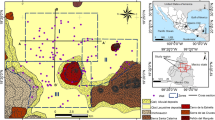Abstract
Earth science phenomena are primarily spatially dependent with variations occurring on varying scales. Geostatistics is a well-known approach for the assessment of spatial models of regionalized variables, such as porosity. In this study, we used the results of 953 Lugeon tests (402 tests in exploratory wells and 550 tests in grouting wells) to assess effective porosity and karst development at the Tangab Dam site, Iran. Lugeon values were first normalized, following which the variogram method (i.e., range, sill, and nugget effect) was used to identify the spatial variability of Lugeon values. A high correlation range of 200 m was obtained along the grout curtain galleries, while the range was about 40 m in the vertical direction. The simple kriging method with Gaussian variograms was determined to be the best method for estimating the Lugeon values in the study area using cross validation-criteria (e.g., RMSE = 0.835 and ρ = 0.914). Spatial variation of Lugeon values was mapped using a simulated annealing approach. The analysis revealed: (1) a higher potential for karst development on the left abutment of the Tangab Dam site, (2) the average of simulated Lugeon values decreased from values of about 180 close to the ground surface at 1,440 m a.s.l. to lower values of about 50 at 1,260 m a.s.l., and (3) high Lugeon values in the abutments of the dam site approximately followed the 15° bedrock dip, which confirms the potential development of karst features in the Asmari limestone. A schematic model for development of karst at the Tangab Dam site is proposed based on hydrogeological data and results of simulated Lugeon values around the dam site.










Similar content being viewed by others
References
Ahmed S (2007) Application of geostatistics in hydrosciences. In: Thangarajan M (ed) Groundwater. Springer SBM, Berlin New York, pp 78–111
Ahmed S, De Marsily G (1987) Comparison of geostatistical methods for estimating transmissivity using data on transmissivity and specific capacity. Water Resour Res 23(9):1717–1737
Asadi N (1998) The study of water tightness problem in Tangab Dam by use of dye tracers. Shiraz University, Shiraz
Bakalowicz M (2005) Karst groundwater: a challenge for new resources. Hydrogeol J 13(1):148–160
Brassington F, Walthall S (1985) Field techniques using borehole packers in hydrogeological investigations. Q J Eng Geol Hydrogeol 18(2):181–193
Deutsch C, Journel A (1998) GSLIB: Geostatistical software library and user's guide, 2nd edn. Applied Geostatistics Series. Oxford University Press, New York
Fars Regional Water Authority (2007) Engineering geology of Tangab Dam site. Fars Regional Water Authority, Shiraz
Ford DC, Williams P (2007) Karst hydrogeology and geomorphology. Wiley, Chichester
Goldscheider N, Drew D (2007) Methods in karst hydrogeology. International contributions to hydrogeology, vol. 26. International Association of Hydrogeologists. Taylor and Francis Group, London
Goovaerts P (1997) Geostatistics for natural resources evaluation. Oxford University Press, Oxford
Hevesi JA, Istok JD, Flint AL (1992) Precipitation estimation in mountainous terrain using multivariate geostatistics. Part I: structural analysis. J Appl Meteorol 31(7):661–676
Houlsby A (1976) Routine interpretation of the Lugeon water test. Q J Eng Geol Hydrogeol 9:303–313
Isaaks EH, Srivastava RM (1989) Applied geostatistics. Oxford University Press, New York
Jaquet O, Siegel P, Klubertanz G, Benabderrhamane H (2004) Stochastic discrete model of karstic networks. Adv Water Resour 27(7):751–760
Karimi H (1998) Hydrogeological and hydrochemical evaluation of springs and piezometers of Podenow anticline. University of Shiraz, Firozabad
Karimi H, Raeisi E, Zare M (2000) Hydrogeology and origin of the Sirezjan Cave, Firozabad. Paper presented at the 4th Conference of the Geological Society of Iran. Tabriz, Iran
Karimi H, Raeisi E, Zare M (2005) Physicochemical time series of karst springs as a tool to differentiate the source of spring water. Carbonates Evaporites 20(2):138–147
Krešić N (2007) Hydrogeology and groundwater modeling. CRC Press, Baton Rouge
Lugeon M (1933) Barrages et Geologie. 138 S. Librairie de l’Université, Lausanne
Merritt AH (1996) Geotechnical aspects of the design and construction of dams and pressure tunnels in soluble rocks. Int J Rock Mech Min Sci Geomech Abstr 2:86A
Milanovic PT (2000) Geological engineering in karst. Zebra, Belgrade
Milanovic P (2004) Water resources engineering in karst. CRC Press, Baton Rouge
Mohammadi Z, Raeisi E (2007) Hydrogeological uncertainties in delineation of leakage at karst dam sites, the Zagros Region Iran. J Cave Karst Stud 69(3):305–317
Mohammadi Z, Raeisi E, Bakalowicz M (2007) Method of leakage study at the karst dam site. A case study: khersan 3 Dam, Iran. Environ Geol 52(6):1053–1065
Neuman SP, Fogg GE, Jacobson EA (1980) A statistical approach to the inverse problem of aquifer hydrology: 2 case study. Water Resour Res 16(1):33–58
North LA, van Beynen PE, Parise M (2009) Interregional comparison of karst disturbance: west-central Florida and southeast Italy. J Environ Manag 90(5):1770–1781
Palmer AN (2000) Hydrogeologic control of cave patterns. In: Klimchouk AB, Ford DC, Palmer AN, Dreybrodt W (eds) Speleogenesis: evolution of karst aquifers. National Speleological Society, Huntsville, pp 77–90
Pardo-Igúzquiza E, Dowd PA, Xu C, Durán-Valsero JJ (2012) Stochastic simulation of karst conduit networks. Adv Water Resour 35:141–150
Parise M, Gunn J (eds) (2007) Natural and anthropogenic hazards in karst areas: recognition, analysis and mitigation. Geol Soc London Spec Publ 279:185–197
Razack M, Lasm T (2006) Geostatistical estimation of the transmissivity in a highly fractured metamorphic and crystalline aquifer (Man-Danane Region, Western Ivory Coast). J Hydrol 325(1):164–178
Talaei H (1999) Investigation on the flow path through the karstic formation of the left abutment of Tangab Dam by the means of rhodamine-B dye tracer. Shiraz University, Shiraz
White WB (1988) Geomorphology and hydrology of karst terrains. Oxford University Press, New York
Yu Y (2010) Geostatistical interpolation and simulation of RQD measurements. University of British Columbia, Vancouver
Author information
Authors and Affiliations
Corresponding author
Rights and permissions
About this article
Cite this article
Akhondi, M., Mohammadi, Z. Preliminary analysis of spatial development of karst using a geostatistical simulation approach. Bull Eng Geol Environ 73, 1037–1047 (2014). https://doi.org/10.1007/s10064-014-0599-3
Received:
Accepted:
Published:
Issue Date:
DOI: https://doi.org/10.1007/s10064-014-0599-3




